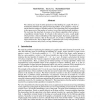2304 search results - page 18 / 461 » On the Vulnerability of Large Graphs |
OSDI
2006
ACM
14 years 10 months ago
2006
ACM
Software attacks often subvert the intended data-flow in a vulnerable program. For example, attackers exploit buffer overflows and format string vulnerabilities to write data to u...
GAMESEC
2010
13 years 7 months ago
2010
We study the strategic interaction between a network manager whose goal is to choose (as communication infrastructure) a spanning tree of a network given as an undirected graph, an...
EUROSYS
2010
ACM
14 years 2 months ago
2010
ACM
A complex software system typically has a large number of objects in the memory, holding references to each other to implement an object model. Deciding when the objects should be...
ACSAC
2010
IEEE
13 years 1 months ago
2010
IEEE
We present a quantitative lower bound on the number of vulnerable embedded device on a global scale. Over the past year, we have systematically scanned large portions of the inter...
NIPS
2008
13 years 11 months ago
2008
We continue our study of online prediction of the labelling of a graph. We show a fundamental limitation of Laplacian-based algorithms: if the graph has a large diameter then the ...

